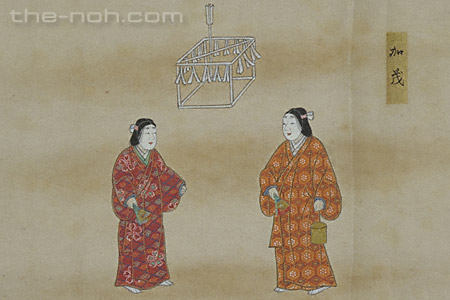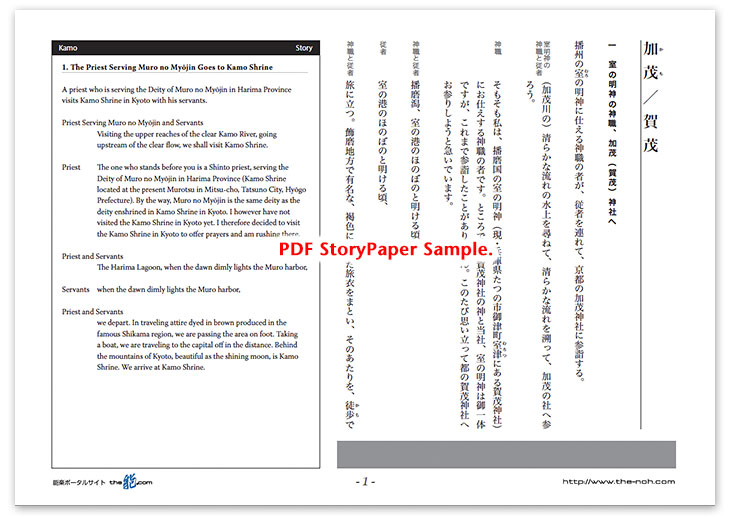
 Kamo
Kamo

![]()
One summer, a priest who serves the deity Muro no Myōjin in the Province of Harima (present southeastern part in Hyōgo Prefecture) visits Kyoto and enters the Kamo Shrine which, he has heard, enshrines the same god as Muro no Myōjin. At the shrine the priest notices an altar into which is thrust an arrow which has white feathers. On this occasion, the women in the village arrive to draw water. The priest takes the opportunity to ask the women about the story of the altar.
The village women tell the priest that the arrow with white feathers embodies the deity of Kamo Shrine, or Muro no Myōjin itself, and describe the detail of its history. “Once upon a time, Hada no Ujinyo who lived in the village of Kamo came to the river every day and drew water to offer the deity. One day, an arrow with white feathers was caught in her pail. She brought it back and stuck it in the eaves of her house, and then she was blessed with a baby boy. When the boy became three years old, he said that his father was the arrow. Then, the arrow immediately transformed into thunder, in other words, the god of Wakeikazuchi, and ran up into the sky.”
Furthermore, they explain that the mother also became a deity, and the arrow, mother, and son are enshrined in three shrines of Kamo. After their story, they start to draw clear water from Kamo River. Since the woman knows the details of the story, the curious priest asks her name. She however refuses to tell her name as it is a shameful act and only reveals her identity as a deity before disappearing.
There then appears before the priest a deity of a lower-ranking shrine, who narrates the story again and dances. After a while, the Deity of Mioya finally reveals itself in the form of a celestial maiden. She beautifully performs the dance of a celestial maiden. Furthermore, the deity of Wakeikazuchi also briskly appears and shows his divine dignity by calling forth a thunderstorm. Eventually, the deity of Mioya flies to the woods of Tadasu, the deity of Wakeikazuchi goes up to the void.
![]()
This piece which comprises a story around a myth related to the famous Kamo Shrines in Kyoto belongs to the waki-noh (the noh of gods, the first group noh). In the first half, shite plays a female character who produces an elegant atmosphere and narrates the myth closely. In the last half, the deity of Mioya, who transforms a celestial maiden, gracefully dances and the deity of Wakeikazuchi dashes around the stage and thunders out his steps imitating the thunder. This piece is filled with highlights.
In ancient times, this piece was known as “Yatate Kamo,” and a structure into which sticks an arrow is placed on the stage.
It is summer. This is a refreshing noh drama, which make us feel the enhanced loveliness of the clear Kamo River. Summer heat in Kyoto would be eased when we see this piece.
STORY PAPER : Kamo
Story Paper presents noh chant stories in modern speech, with story outlines, highlights and more using Adobe PDF format, which can print out and zoom in. Print out the pages and take them with you when you see the actual noh performance.

The copyright of Story Paper is held by the Noh.com. Story Paper is for individual use only. It is prohibited by the copyright law to distribute or publish printed-out Story Paper pages without prior consent. For more information, check the credit and disclaimer pages.



 [Kamo : Story Paper PDF : 505KB
[Kamo : Story Paper PDF : 505KB